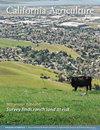洪堡县林地和牧场主对大麻的认知
IF 1.1
4区 农林科学
Q2 AGRICULTURE, MULTIDISCIPLINARY
引用次数: 5
摘要
大麻通常种植在加州的农田和林地上,但随着大麻在州法律下合法化,人们对传统农业和木材生产商的生计做出的调整知之甚少。我们在这项研究中的目标是更好地了解那些世代生产木材和牛的大土地所有者是如何在他们的地区经历大麻产量增加的,同时也更好地了解这些土地所有者对大麻对他们社区的影响(无论是积极的还是消极的)的看法。为了实现这一目标,我们调查了洪堡县至少拥有500英亩土地的土地所有者,40多年前,这个地区成为加州第一个开始大规模种植大麻的县之一。我们邀请了211位土地所有者完成一项调查,其中71位做出了回应,提供了他们对大麻生产的经验和看法的见解。许多调查答复者报告了在其财产上非法种植、共用道路问题以及大麻生产的其他直接负面影响。大多数土地所有者还报告说,大麻生产增加了劳动力成本,尽管他们承认大麻生产也增加了他们财产的价值。然而,调查对象并没有因为大麻合法化而改变他们对大麻的看法。这项研究的结果说明了在制定土地使用条例和其他政策时所面临的一些挑战,这些条例和政策可以支持多个行业,这些行业的利益可能处于竞争之中。本文章由计算机程序翻译,如有差异,请以英文原文为准。
Perceptions of cannabis among Humboldt County timberland and ranchland owners
Cannabis is often grown on agricultural and forest lands in California, but little is known about the adjustments that traditional agriculture and timber producers are making to their livelihoods as cannabis becomes legal under state law. Our goal in this research was to better understand how larger landowners, whose families have often produced timber and cattle for generations, are experiencing increased cannabis production in their areas — and also to better understand these landowners' perceptions of the impacts of cannabis, whether positive or negative, on their communities. To accomplish this, we surveyed landowners who owned at least 500 acres in Humboldt County, an area that — more than 40 years ago — became one of the first California counties to begin experiencing expansive cannabis cultivation. Of the 211 landowners we invited to complete a survey, 71 responded, providing insights into their experiences with and perceptions of cannabis production. Many survey respondents reported illegal cultivation on their properties, problems with shared roads and other direct negative effects of cannabis production. Most landowners also reported that cannabis production has increased the cost of labor, though they acknowledge that it has increased the value of their property as well. Survey respondents, however, have not changed their views of cannabis with legalization. The findings of this study illustrate some of the challenges involved in developing land use ordinances and other policies that can support multiple industries whose interests may be in competition.
求助全文
通过发布文献求助,成功后即可免费获取论文全文。
去求助
来源期刊

California Agriculture
农林科学-农业综合
CiteScore
2.40
自引率
7.70%
发文量
17
审稿时长
>12 weeks
期刊介绍:
Information not localized
 求助内容:
求助内容: 应助结果提醒方式:
应助结果提醒方式:


